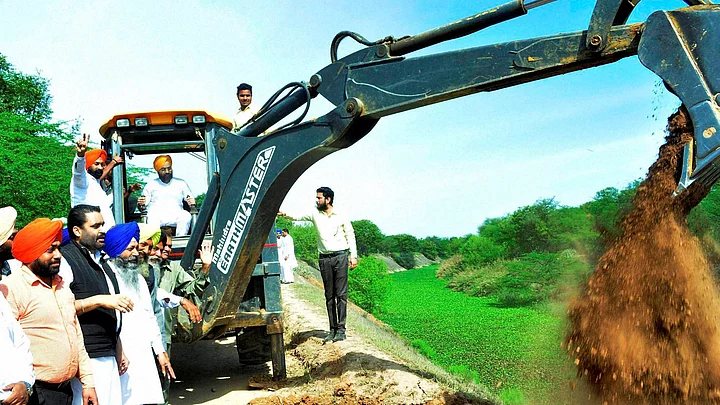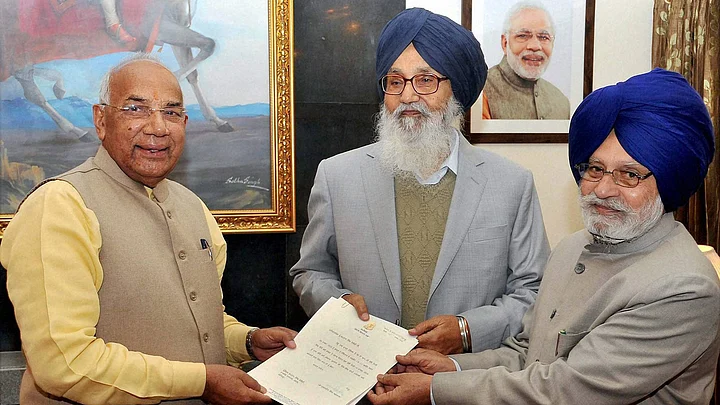The river waters issue continues to rankle Punjab because its case is infallible. It is for this reason that farmers have been up in arms since the late 1970s. It was one of the major causes behind law and order spiralling out of control in Punjab in the early 1980s, which is too painful to recount.
Unfortunately, almost all political parties, including the Congress, Shiromani Akali Dal and the BJP – at the Centre and in states -- have bungled over the issue from time to time. The recent crisis that has built up over the Sutlej-Yamuna Link Canal is primarily due to competitive politics of these parties to undo their own wrongs in the past.

History of Conflict
Since the Pandora’s Box on the river waters issue has now been opened, the matter needs to be looked at in its entirety. Only a just solution based on the internationally accepted riparian principle as well as sharing of resources between the states in question will help resolve this vexed issue.
Why is the river waters issue so emotive in Punjab? This has its basis in the partition of India in 1947 when Punjab lost its newly colonised land to what is now West Punjab or Pakistan’s Punjab. What was left in India was adh-Punjab (half-Punjab). As a consequence, the Indus Waters Treaty of 1960 between India and Pakistan, deprived Punjab of much of its water.
While West Punjab got its water from Chenab, Jhelum and Indus rivers, East Punjab got its share from Ravi, Beas and Sutlej rivers. Punjab has continued to suffer also on account of continuing India-Pakistan tension because of which waters of the Ravi, which meanders along the Punjab border for a considerable length, have never been fully harnessed. The division of Indian Punjab in 1966 on linguistic basis due to the SAD’s shortsighted and parochial politics further complicated matters. But that issue is best left for another day.
What is worse is that arbitrary and illegal actions of successive Union governments facilitated by a weak political leadership in Punjab have deprived the state of a substantial part of its allocated river water – erroneously declared “surplus” -- by giving it to Haryana and Rajasthan.

Vying for Farmers’ Sympathy
- Row over the
Sutlej-Yamuna Link Canal is primarily due to competitive politics of various
parties trying to cover up for past mistakes.
- Water treaty signed post-partition deprived Punjab of much of its water with the division of the state in
1966, complicating matters further.
- Unlike Punjab,
water arrangement for Rajasthan through the Ganga Canal and the Bhakra
Nangal Agreement has worked for the non-riparian state.
- The reality of
scarcity dawned on the politicians when the demand for irrigation water
increased with the advent of the Green Revolution.
- Since then
various political parties in Punjab have vied with each other to “protect” the
interests of the state’s farmers.
Water Bounty to Rajasthan
Take the case of Rajasthan, which gets water from three primary systems. The first is the pre-Partition arrangement relating to the Ganga Canal, which is often referred to as the Bikaner Canal (as the area of Sri Ganga Nagar district was a part of Bikaner state). The canal was built as a part of the Sutlej Project between 1920 and 1926 to provide 2,720 cusecs of water (about 1.11 MAF or million-acre feet) to Rajasthan. The project was built by the then government of Punjab, Bahawalpur state (now in Pakistan) and the Bikaner state (a part of Rajasthan now).
It was clearly provided in the agreement that the “interests of Punjab state would not be jeopardised.” This was a very fair deal as during colonisation, besides locals, a lot of people from joint Punjab (including Sikhs) were settled on the Ganga Canal lands.
The second source of water that Rajasthan gets is of the Sutlej River, which is a part of the Bhakra Nangal Agreement of 1959. Since Rajasthan shared the Bhakra Nangal Project both in irrigation and power, its share was worked out to be 15.22 per cent. Rajasthan gets about 1.5 MAF water from the Bhakra Project. As far as this arrangement goes, there are no quibbles.

Politics over Water
However, the cribbing is about the “surplus” Ravi-Beas waters, given to Rajasthan through an “agreement” brokered by the Union government on 29 January, 1955, with the states of Punjab, PEPSU (Patiala and East Punjab States Union) and Rajasthan. PEPSU later became a part of Punjab. Rajasthan was allotted 8.0 MAF (later raised to 8.6 MAF), which was given to it through Rajasthan Canal (later named Indira Gandhi Canal).
Clearly, Punjab got a raw deal as the then Congress government in the state failed to protect its interests. Rajasthan was given the bounty of Ravi-Beas waters despite not being a non-riparian state. It is not out of context to mention that Rajasthan’s claim on the Narmada river waters were denied in 1972 by the tribunal set up for the purpose since it was not a non-riparian state.
While in the initial years, Punjab’s political leadership did not realise the oversight of having provided water to a non-riparian state, the reality dawned on them as and when the demand for irrigation water increased in Punjab with the advent of the Green Revolution. And since then, Punjab’s political parties have been protesting, though meekly, and often acquiescing to remain in power.
The
1955 “agreement” hurt the interests of Punjab’s farmers severely. The Rajasthan
Canal was conceived as a central project by which it can
draw up to 18,500 cusecs of water. Rajasthan’s entitlement has been worked out
to be 8.6 MAF.
Incidentally, the 1955 “agreement” per se has little legal sanctity as it is more of an executive order. However, it got validated, first through the tripartite agreement of December 31, 1981, and then the Rajiv-Longowal Accord of 1985. The Eradi Tribunal appointed as a result of the Rajiv-Longowal Accord further put its seal on the issue on January 30, 1987, when it gave its conclusions on the matter referred to it. Since then various political parties in Punjab have vied with each other to “protect” the interests of the state’s farmers.
(The writer is a Chandigarh-based senior journalist)
This is part one of a two-part series tracing the background of the inter-state river waters dispute between Punjab, Haryana, Rajasthan and Delhi.
(At The Quint, we are answerable only to our audience. Play an active role in shaping our journalism by becoming a member. Because the truth is worth it.)
